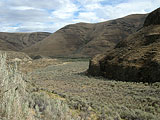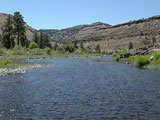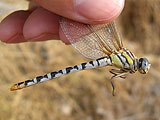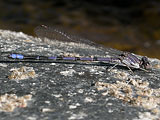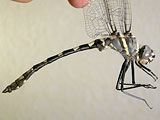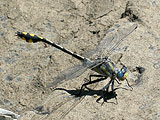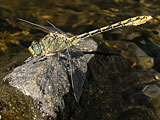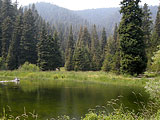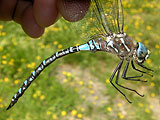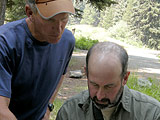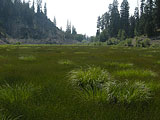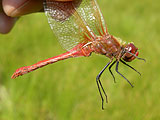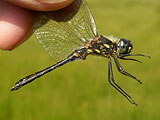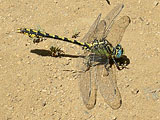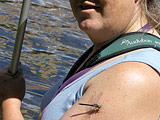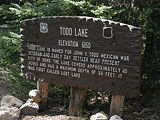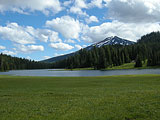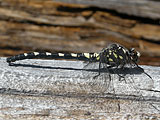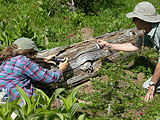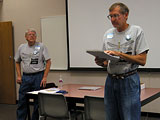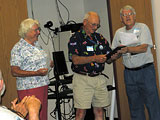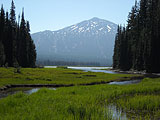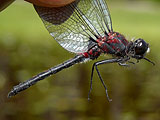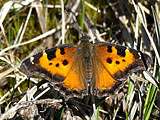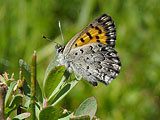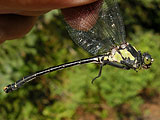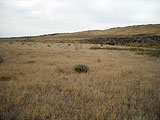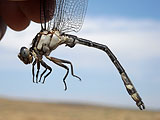
Oregon, July 29 - August 7, 2008
Dragonfly Society of the Americas Annual Meeting including pre- and post-meeting trips.
Tues, July 29: My long day of travel began with an 8 AM Eastern time flight out of New York. After a stop in Minneapolis I arrived in Portland, Oregon around 1:30 PM Pacific time. On the plane I saw a couple of familiar faces also heading for the DSA meeting, Dave Small and Dave Fitch. At the rental car counters I waved to Bryan Pfeiffer and Mike Veit but they had to wait for Mike Blust whose flight out of New England was cancelled. Traveling solo I rented a car and headed off to the town of John Day five hours and 270 miles away.
Who is John Day? According to the city of John Day website, John Day was a hunter out of Virginia who traveled to Oregon in 1812 while employed by the Pacific Fur Company. He suffered a great many hardships during the journey including illness and indian attack. People started calling the Mau Mau River, the site of the indian attack, the "John Day River" and the name stuck. Exactly why 2 towns, a river with four branches, and a large dam on the Columbia River is named for him is not clear. The circumstances of his death are also murky. He probably died in 1819 in Idaho (where a river drainage is named after him, the John Day Defile). Other reports have him attempting to commit suicide then dying alone in the wilderness in 1812 .
Driving east out of Portland along the wide Columbia River I was surprised how dry the landscape was. Wasn't the Pacific Northwest supposed to be green and wet? I stopped briefly late in the afternoon at a crossing of the John Day River were I would see the first of many Emma's Dancers Argia emma, a Blue-eyed Darner Rhionaeschna multicolor, and a female White-belted Ringtail Erpetogomphus compositus. I got to the motel at John Day at 8 PM local time (11 PM in the East) so I was pretty beat. Still I stayed awake to meet with some of the participants and get a sense of what was flying in the area. Jim Johnson, one of the meeting organizers gave me a couple of specimens of Western River Cruiser Macromia magnifica and Pacific Spiketail Cordulegaster dorsalis (Thanks, Jim!) so I broke out the scanner before getting to bed.
Wed, July 30: The choices for the day was exploring the John Day River and its tributaries or heading into the Strawberry Mountain Wilderness and the Malheur National Forest. Most seem to be heading for the mountains to Magone or Canyon Meadow Lake but because I had targeted the endemic Columbia Clubtail Gomphus lynnae, I headed to the river. I drove an hour to the Muleshoe campground and almost immediately flushed a female clubtail feeding along the shoreline. I was frustrated when I lost her but it turned out the clubtail was fairly common. Males were flightier than the females but I caught all I needed in short time. I spent the rest of the morning along the river looking for Sinuous Snaketail Ophiogomphus occidentis but found none. Occasionally a Western River Cruiser would fly by and there were lots of Emma's Dancers but otherwise the river was quiet.
In the afternoon I tried the south fork of the John Day River (south of DAYville). Greg Lasley reported seeing lots of Pale Snaketail Ophiogomphus severus here and I found numerous males. I waited throughout the afternoon hoping for a female. There might have been one but an Empidonax flycatcher came down and caught it off the surface of the water. It could have been a male.
That evening the group reported finding Mountain Emerald Somatochlora semicircularis, Variable Darner Aeshna interrupta, and various species of meadowhawk Sympetrum. Sounds good, tomorrow I'll head to the mountains.
Thurs, July 31: I got up a little late so I ordered breakfast to go, a bacon, egg, and cheese on a roll. This caused a little confusion at the local restaurant. See here. Then I joined Bryan Pfeiffer and the Mikes, Veit and Blust, to try the mountain lakes.
We went to Trout Camp Lake in the Malheur National Forest where Mountain Emeralds were reported. It's a picturesque spot, with Western Tanagers in the pines, and wildflowers full of butterflies. But whoops, those Mountain Emeralds were American Emeralds Cordulia shurtleffii, a dragonfly more familiar to us Northeasterners. However Bryan did spot the slimmer Mountain Emerald and I managed to net it as it hovered near me. We caught a few darners, Variable, Paddle-tailed palmata, and Blue-eyed. But my highlight was a lifebird, as a group of Vaux's Swifts flew around the lake feeding and drinking.
In the afternoon we tried Canyon Meadow Lake, a large wet meadow. There once was a lake here but the dam has long been breached. I chased after and caught another Mountain Emerald then later caught a couple of species of meadowhawk, notably Black Sympetrum danae and Red-veined S. madidum. Along the stream we found more Pale Snaketails and Pacific Spiketails.
We returned to John Day for supper then it was back in the cars for the 150 mile drive to the city of Bend where the DSA meeting will be held. Then more scanning before another long day is over.
Fri, Aug 1: Bend. I hitched a ride with Pam Hunt for the day and I was grateful for the break from driving. We first tried a couple of spots along the Deschutes and Fall Rivers. We found a couple of Great Basin Snaketails Ophiogomphus morrisoni but not much else. Then we hit the Great Basin Snaketail jackpot at the outlet of the Crane Prairie Reservoir. Dozens of snaketails were foraging along the road. Males and females, I have never seen a species of snaketail so numerous. Also present were lots of darners, mostly Variable and Blue-eyed but Dennis Paulson caught a California Darner Rhionaeschna californica. Some of the Variable Darners were small with pretty solid lateral thoracic stripes. They puzzled me and I had to consult the local experts who called them Variable, perhaps the disputed ssp. nevadensis. Also present were Chalk-fronted Corporal Ladona julia and many Eight-spotted Skimmers Libellula forensis.
We tried Little Cultus Lake in the Deschutes National Forest for Pacific Clubtail Gomphus kurilis but found none. They were likely done for the year. Pam then caught a new species for the day, Ringed Emerald Somatochlora albicincta, a male.
Our last stop was Todd Lake for Black Petaltail Tanypteryx hageni, an attractive relic dragonfly in the family Petaluridae and a highlight of the trip. We didn't get there until 4 PM but the parking lot was still full of the cars of daytrippers, hikers, and of course dragonflyers. It was a bit surprising to find snow still on the trail but just a couple hundred feet beyond we found our first petaltail, a female. Small and dark she acted like a slow flying clubtail, landing on logs and on the ground. The second, a male was perched on a tree trunk. On the other side of the lake we met up with other DSA members and saw more petaltails sunning themselves on logs.
Sat, Aug 2: After four long days of dragonflying and travel, it was kind of nice to spend the day inside for the DSA business meeting and listen to the talks. Congratulations to Nick and Ailsa Donnelly in recognition of their service to the society. I enjoyed the talks, the slides of dragonfly images kept me interested but those presentations that were mostly text had me nodding off.
Sun, Aug 3: Spent the last official day of the meeting with Jerrell Daigle and Kathy Kozacky at Sparks Lake. I was hoping for Zigzag Darner Aeshna sitchensis but none were found during the meeting. There were plenty of other darners again mostly Variable. We looked for unusually dark variations of Hudsonian Whiteface Leucorrhinia hudsonica, and Mountain Emeralds were plentiful. Jerrell caught a couple of young female Ringed Emeralds while I was hoping to find a mature one. We tried to catch a male at Sparks Lake and later at Todd Lake but failed. I found a freshly emerged female at Todd Lake and decided to collect her because she had deformed wings and would not survive in any case.
Mon, Aug 4: This was the designated post trip day. It didn't start well. I got up to scan the female Ringed Emerald but she wasn't on the perch I left her on the night before. With her deformed wings I knew she couldn't have gone far but I couldn't find her until I was putting on my shoes. Oh there she is. Darn.
I set out for Gold Lake, the site for Grappletail Octogomphus specularis. A cool bug, it's named for the male's impressive antler-like terminal appendages. In the previous days I got to see specimens that others had caught but I wanted to see them in the wild and also collect a female. Along the way to Gold Lake, my GPS suggested a dirt road. A sign said "Not maintained for passenger vehicles." Since the rental I was driving was a KIA Spectra, a compact, I didn't risk it and turned back onto the main road. Then the GPS directed me onto another dirt road. It didn't look bad so I took it. The road was fine for a few miles but then started to dwindle. I got pretty nervous about getting stuck somewhere. A black bear ran across the road. I was counting down the miles to the main road and the last couple were the worst. Towards the end I was relieved to see traffic ahead through the trees. But then the track made a turn AWAY from the road. I couldn't believe it. The dirt road used to lead to the paved one but now that access was blocked with debris. The GPS and I were confused of what to do as we continued to snake along the dirt track. It went through a logging area and finally, gratefully, turned back towards the blacktop.
When I got to the lake, I immediately found a couple of male Grappletails. I netted a young male still yellow rather than gray. The temperature was still cool so I checked sunny patches for females. I went downstream balancing myself on logs. There weren't any dragonflies there so I don't know why I stepped further but I stepped down onto another log but found it unsupported. I splashed into the water. The water was so clear to the bottom it didn't look very deep but I was over my head. I pulled myself back out and my thoughts immediately went to the camera that was in my pack.
It was dead (the third camera I've dunked over the years). I spent quite a bit of time laying out the contents of my pockets to dry on the car and got changed. Meanwhile more and more Grappletails appeared. I missed out on taking any field photos of them, even the mating pairs that posed in the brush.
I stayed at Gold Lake longer than I planned but still headed south to look for Walker's Darner Aeshna walkeri. Jim Johnson had given me a site to try but it was 144 miles and three hours away. I made it to Jenny's Creek at Pinehurst at 4:30 PM. I clamored down the bank from the road and saw a darner fly along a little stream. I got to the edge and caught it, a male Walker's Darner with whitish thoracic stripes and just large blue spots on the abdomen. I saw a few more males but they got scarcer as it got later. It seemed very unlikely that I would find a female.
I debated whether I should stay the night nearby to try again but decided not to. I was leaving Portland Thursday morning so I only had 2 more days. I wanted to go to Vancouver, WA for Olive Clubtail Stylurus olivaceus and try again for Sinuous Snaketail. If the snaketail was gone from the John Day then probably I should head north where they may still be flying. I decided to head back to Bend. It wasn't the most direct route to Portland and Vancouver but this way I could try to find another female Ringed Emerald in the morning to replace the one I crushed in my shoe.
Another long drive, 3 and a half hours, I was on the outskirts of Bend when a State trooper pulled me over. I was trying to get in town by 10 PM. I was apologetic and fortunately only got a warning. I checked into a motel, scanned for a couple of hours and went to bed, the most trying day of the trip thankfully over.
Tues, Aug 5: I tried taking the camera to a repair place that was listed in the phone book. When I got to the address there was a trailer but no signs and I decided against knocking. I went to Walmart and bought an point and shoot then headed back to Sparks Lake.
I caught the male Ringed Emerald that Jerrell was hoping for. There were very few darners this morning compared to a couple of days ago. I watched another male Ringed Emerald patrolling the edge of a pond. I saw him dip down to the ground then fly up again. I went to the spot to investigate and there nestled in the vegetation was a green-eyed female Ringed Emerald. I would have never have seen her if I wasn't watching the male.
Then I drove over 200 miles to Vancouver's Wintler Park to look for Olive Clubtail. As I was arriving who would I see but Jim Johnson, Ken Tennessen, and Jerrell Daigle. "There's still some down there," they tell me. But I'm turned away because there's no parking available. Although it's late on a Tuesday afternoon, the only parking lot is full because there's a heat wave and people are trying to keep cool by the waters of the Columbia River. Jim directs me to nearby Marine Park so I try it but don't see a single dragonfly. Frustrated, I check into a motel in Portland for the night.
Weds, Aug 6: Last day, I have a decision to make. I could go back to Wintler Park for Olive Clubtail. The guys had them so they would be a sure thing. But they would probably be the only thing. I could head to another location where both Olive Clubtail and Sinuous Snaketail have been recorded. Only problem, the location is 230 miles away. Well, you gotta try. I get up early and drive, arriving at Horn Rapids Park in Benton Co. Washington around 10 AM. It's hot on the Yakima River and Blue-eyed Darners are hanging up in the shade of the few trees along the bank. There are Western Meadowhawks Sympetrum occidentale, Western Pondhawks Erythemis collocata, but I initially find no clubtails. I make my way to the riffles, the Rapids, hoping that the snaketails would be more likely there. There are lots of White-belted Ringtails. Working back along the river a dragonfly lands in some tall grasses. It's a male Olive Clubtail and I manage to net it. It clouds over but the cover doesn't bring any other dragonflies out. The sound of gunfire from the shooting range across the road makes me nervous but it's the poor weather that convinces me to head back to Portland.
I get back with still enough time to give Wintler Park a look. I get hung up at a freight train crossing but I have no trouble getting into the park even thought it's about the same time of day as yesterday and it's still hot. I immediately flush some Olive Clubtails. They are perching on shrubs and small trees along the beach. As they flush, most fly up and back into the trees presumably to roost for the night. They all seem to be males. I get a few looks but no swings and then, they all seem to be gone. I try the other side of the beach. Two are on a small tree, one flies off but the other re-settles and I net him. Later I check sunny spots away from beach. I flush a few more, they are mostly high in trees impossible to detect before they fly.
Thurs, Aug 7: The flights are non-eventful and even on time until bad weather in the New York area has us circling around eastern Pennsylvania for an hour.
It was a good but exhausting meeting. A lot of targets were hit and the few misses weren't missed due to a lack of trying. Many thanks to the organizers, Jim Johnson and Steve Valley!
